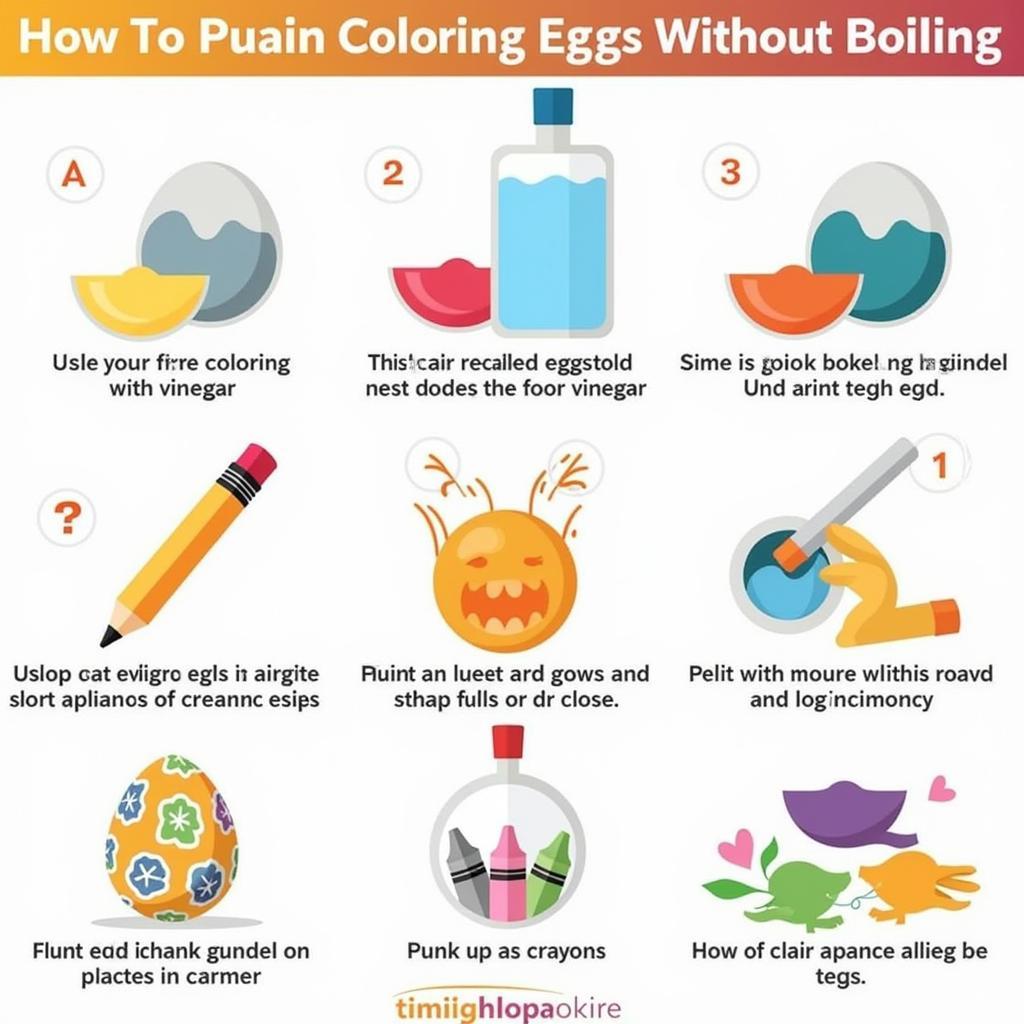Yes, you absolutely can color eggs without boiling them! Many people associate egg dyeing with the traditional boiling method, but several alternative techniques offer exciting possibilities for decorating eggs, especially for crafts with kids or those seeking a less messy approach. These methods open up a world of vibrant colors and creative designs without the heat and potential for cracked shells.
 Coloring Eggs Without Boiling: Various Methods
Coloring Eggs Without Boiling: Various Methods
Exploring No-Boil Egg Coloring Techniques
Several methods allow you to transform ordinary eggs into colorful masterpieces without the need for boiling. Each technique offers a unique approach and results, catering to different skill levels and aesthetic preferences.
Dyeing Eggs with Food Coloring and Vinegar
This method is a simple and effective way to achieve vibrant colors. Mix food coloring with vinegar and submerge the eggs for a few minutes to several hours, depending on the desired intensity. The vinegar helps the color adhere to the eggshell. This technique is perfect for creating classic, brightly colored Easter eggs.
Decorating Eggs with Markers and Crayons
Unleash your inner artist by using markers or crayons directly on the eggshells. This method is excellent for detailed designs, intricate patterns, and personalized messages. You can even use metallic markers for a touch of shimmer and shine. This dry method is also less messy and perfect for young children.
Painting Eggs with Acrylic or Watercolor Paints
For a more sophisticated approach, try painting your eggs with acrylic or watercolor paints. This technique allows for greater control and precision, enabling you to create intricate designs and artistic masterpieces. You can even use stencils or stamps to add unique patterns and textures. Seal your painted creations with a clear varnish for a glossy finish.
Why Choose No-Boil Egg Coloring?
No-boil egg coloring methods offer several advantages over traditional boiling, making them a popular choice for many.
- Safety: Eliminates the risk of burns from hot water, making it a safer option for children.
- Convenience: No need to handle hot eggs or worry about cracked shells during the boiling process.
- Creativity: Offers a wider range of decorating techniques and allows for more intricate designs.
- Less Mess: Many no-boil methods are significantly less messy than traditional dyeing.
“No-boil methods are a game-changer, especially when working with young children,” says Amelia Hart, a renowned art educator specializing in children’s crafts. “It eliminates the safety hazards of boiling water and allows kids to focus on the creative process.”
How Do You Color Deviled Eggs?
While the focus here is on decorating whole eggs, you might be interested in learning how to add color to deviled eggs. Check out our guide on how do you color deviled eggs for creative ideas and techniques to make your deviled eggs even more appealing.
Tips for Successful No-Boil Egg Coloring
- Clean Eggs: Start with clean, dry eggs for better color adhesion.
- Room Temperature: Let your eggs come to room temperature before decorating.
- Experiment: Don’t be afraid to experiment with different colors, techniques, and materials.
- Seal Your Artwork: Apply a clear sealant to protect your painted eggs and enhance their shine.
“The beauty of no-boil egg coloring lies in its versatility,” says David Miller, a professional artist specializing in egg art. “It allows you to explore various artistic techniques and create truly unique pieces.”
Conclusion: Embrace the Colorful World of No-Boil Egg Decorating
Can You Color Eggs Without Boiling Them? Absolutely! Embrace the simplicity, safety, and creative possibilities of no-boil egg coloring techniques. Whether you prefer the classic look of dyed eggs or the intricate details of painted designs, there’s a no-boil method perfect for you. So, gather your supplies and let your creativity flow!
FAQ
-
What type of vinegar should I use for dyeing eggs? White vinegar is recommended.
-
Can I use natural food coloring? Yes, natural food coloring can be used, but the colors may be less vibrant.
-
How long should I leave the eggs in the dye? The time varies depending on the desired color intensity, typically from a few minutes to several hours.
-
What kind of paint is best for decorating eggs? Acrylic or watercolor paints work well.
-
Do I need to seal painted eggs? Sealing your painted eggs with a clear varnish or sealant will protect them and add shine.
-
Can I use crayons on real eggs? Yes, crayons work beautifully on real eggs and are a great option for kids.
-
What other materials can I use to decorate eggs? Glitter, stickers, ribbons, and other craft supplies can be used to enhance your egg decorations.
Common Scenarios & Questions
Scenario: You’re planning a craft activity with young children.
Question: What’s the safest way to color eggs with kids? No-boil methods, particularly using markers or crayons, are the safest.
Scenario: You want to create intricately designed Easter eggs.
Question: What coloring method offers the most precision? Painting with acrylics or watercolors provides the best control for intricate designs.
Further Exploration
For more tips and ideas, explore other articles on our website related to egg decorating and crafts.
Need Help?
For assistance with your color projects or design inquiries, contact us:
Phone: 0373298888
Email: [email protected]
Address: 86 Cau Giay, Hanoi
Our customer service team is available 24/7.